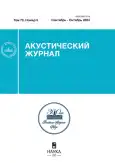Study of the Acoustic Perceptibility of Vehicles Moving with a Constant Speed
- Authors: Subbotkin A.O.1,2,3, Kuznetsov G.N.4, Talachev E.V.3, Romanenko G.A.5, Tyurin A.S.2,3
-
Affiliations:
- A. M. Prokhorov General Physics Institute of the Russian Academy of Sciences
- Research Institute of Building Physics of the Russian Academy of Architecture and Construction Sciences
- Kar Systems LLC
- A.M. Prokhorov General Physics Institute of the Russian Academy of Sciences
- Devesoft Rus LLC
- Issue: Vol 70, No 5 (2024)
- Pages: 757-764
- Section: АКУСТИЧЕСКАЯ ЭКОЛОГИЯ. ШУМЫ И ВИБРАЦИИ
- Published: 15.09.2024
- URL: https://transsyst.ru/0320-7919/article/view/648441
- DOI: https://doi.org/10.31857/S0320791924050107
- EDN: https://elibrary.ru/XBFWOS
- ID: 648441
Cite item
Abstract
The paper presents the results of an experiment on the assessment of subjective indicators of acoustic perceptibility by pedestrians (experts) of a vehicle approaching at a constant speed (TS) and some conclusions. Subjective indicators of perceptibility were defined as the distance between the vehicle and the expert, at the moment when the expert heard (recorded) the sound of an approaching car, as well as the time of the car's approach to the expert at that moment. Subjective indicators of perceptibility are compared with the objective parameters of car noise measured by the method of UN Regulation No. 138 — the sound pressure level, its frequency response, as well as the sound level. The study is motivated by the problem of traffic safety of electrified vehicles with low noise, which include, in particular, electric cars, electric scooters and electric scooters. This article publishes the first results of a research paper devoted to the problem of increasing the perceptibility of low-noise vehicles for pedestrians without damaging the acoustic ecology of cities and suburbs.
Full Text
About the authors
A. O. Subbotkin
A. M. Prokhorov General Physics Institute of the Russian Academy of Sciences; Research Institute of Building Physics of the Russian Academy of Architecture and Construction Sciences; Kar Systems LLC
Author for correspondence.
Email: subov-an@yandex.ru
Russian Federation, Moscow; Moscow; Moscow
G. N. Kuznetsov
A.M. Prokhorov General Physics Institute of the Russian Academy of Sciences
Email: subov-an@yandex.ru
Russian Federation, Moscow
E. V. Talachev
Kar Systems LLC
Email: subov-an@yandex.ru
Russian Federation, Moscow
G. A. Romanenko
Devesoft Rus LLC
Email: subov-an@yandex.ru
Russian Federation, Moscow
A. S. Tyurin
Research Institute of Building Physics of the Russian Academy of Architecture and Construction Sciences; Kar Systems LLC
Email: subov-an@yandex.ru
Russian Federation, Moscow; Moscow
References
- Zhang E.L., Peng Z.L., Li Z.J., Lin Y.B., Zhuo J.M. Four-Channel Active Noise Control Modeling and Offline Simulation for Electric Bus Sound Quality Based on Two FxLMS Algorithms // Acoust. Phys. 2024. V. 70. № 1. P. 143-152.
- Правила ЕЭК ООН № 138. Единообразные предписания, касающиеся официального утверждения бесшумных автотранспортных средств в отношении их пониженной слышимости. 05 октября 2016. 43 с.
- ГОСТ Р 53188.1-2019. Государственная система обеспечения единства измерений. ШУМОМЕРЫ. Часть 1. Технические требования.
- Римская-Корсакова Л.К., Пятаков П.А., Шуляпов С.А. Оценки раздражающего действия шума // Акуст. журн. 2022. Т. 68. № 5. С. 550–561.
- Цвикер Э., Фельдкеллер Р. Ухо как приемник информации. Изд. 2. 1971.
- Вахитов Я.Ш. Слух и речь. Л.: ЛИКИ. 1973. Т. 124.
- Sakamoto I., Tanaka T., Sekine M., Morita K., Masayuki S., Takeshi K. and Yoshiike A. Reviews on countermeasure to safety risk associated with quietness of hybrid or electric vehicles in Japan // Proc. Inter-noise 2010. 2010. 8 p.
- Guideline for the Approaching Vehicle Audible System. Ministry of Land, Infrastructure, Transport and Tourism (MLIT), 2010. (in Japanese)
- Proposal for guidelines on measures ensuring the audibility of hybrid and electric vehicles. Consolidated Resolution on the Construction of Vehicles (R.E.3), Annex 2, ECE/TRANS/WP.29. Geneva, Swizerland, 2011.
- On the sound level of motor vehicles and of replacement silencing systems: Regulation (EU) No 540/2014 of the European Parliament and of the Council of 16 April 2014, amending Directive 2007/46/EC and repealing Directive 70/157/ EEC // Official Journal of the European Union 158. 2014. P. 131–195.
- Quieter Cars and the Safety of Blind Pedestrians: The NHTSA Research Plan, April 2009. www.regulations.gov (Docket No. NHTSA-2008-0108-0025)
- Garay-Vega, et al. Quieter Cars and the Safety of Blind Pedestrians: Phase I, Report No. DOT HS811 304, U.S. Dept. of Transportation, Washington, DC. 2010.
- Garay-Vega et al. Quieter Cars and the Safety of Blind Pedestrians, Phase 2: Development of Potential Specifications for Vehicle Countermeasure Sounds, Report No. DOT HS811 496. Dept. of Transportation, Washington, DC. 2011.
- Evans L.R. and Harris J.R. Quieter Vehicle Performance Test Development Research Report, Report No. DOT HS810, Dept. of Transportation, Washington, DC.
- Hastings A., Guthy C. and Pollard J.K. Research on Minimum Sound Specifications for Hybrid and Electric Vehicles, Report No. DOT HS810, Dept. of Transportation, Washington, DC.
- Проект рекомендаций по глобальным техническим правилам, касающимся систем звукового оповещения о наличии транспортного средства для бесшумных автотранспортных средств, ECE/TRANS/WP.29/GRB, 56 сессия, Женева, 3–5 сентября 2012 г.
- Moore, et al. A model for the prediction of thresholds, loudness, and partial loudness // J. Audio Eng. Soc. 1997. V. 45(5).
- Federal Motor Vehicle Safety Standards; Minimum Sound Requirements for Hybrid and Electric Vehicles; Notice of proposed rulemaking, Dept. of Transportation, Washington, DC, Federal Register. V. 78. No. 9. January 14, 2013. P. 2798–2868.
- Pedestrian Safety Enhancement Act of 2010, Public Law No: Public Law No. 111–373 (01/04/2011).
- GB/T 37153-2018. Acoustic vehicle alerting system of electric vehicles running at low speed, State Administration for Market Regulation; Standardization Administration of the People's Republic of China. December 2018.
- Технический Регламент Таможенного Союза ТР ТС 018 / 2011 “О безопасности колесных транспортных средств”.
Supplementary files















